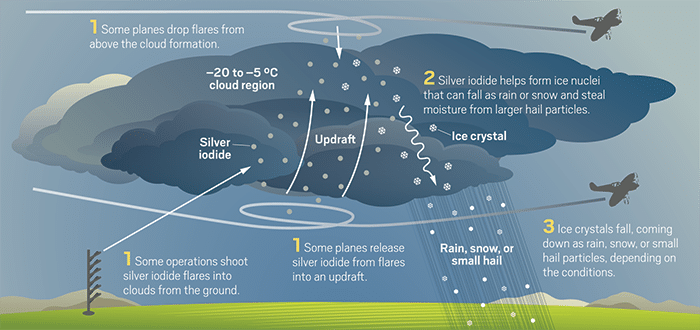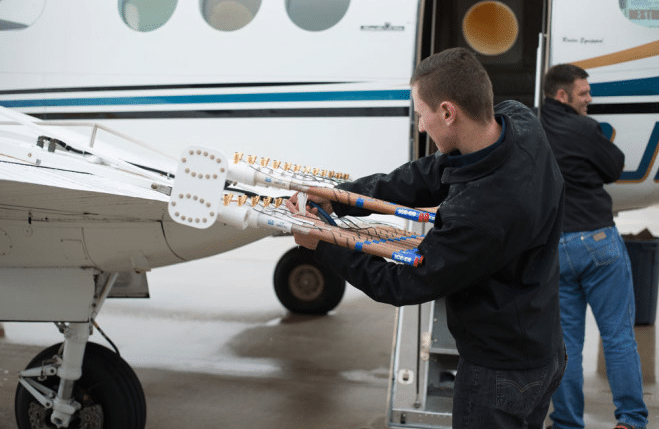Since its inception in the 1940s, cloud seeding has evolved into a potential solution to droughts, a tool for firefighting, and a catalyst for weather modification. As we navigate through the promises and perils, this journey unfolds the different dimensions of cloud seeding, where advocates champion its efficacy, skeptics raise cautionary flags, and the environment holds its secrets.
—
Cloud Seeding Debate: Advocates, Skeptics, and the Chemical Mix
As we peer through our windows, contemplating the day’s weather forecast, the idea of influencing the skies becomes more tangible. The mysterious interaction between cloud droplets and the profound science behind weather modification have propelled cloud seeding into the spotlight – a realm both captivating and contentious. At its essence, cloud seeding ambitiously attempts to assist Mother Nature by introducing into the clouds additional “nuclei” around which water condenses, stimulating precipitation. However, this technological tool prompts intriguing questions. Could cloud seeding be a solution to drought or aid in fighting forest fires? Could increased precipitation in one area inadvertently trigger a drought elsewhere? Might cloud seeding cause excessive rain, leading to flooding? The answers aren’t straightforward, as conjuring clouds remains beyond its current scope.
The cloud seeding industry has always been a topic of debate. Advocates highlight its efficacy, with studies indicating a 10-15% increase in rainfall. Conversely, skeptics raise cautionary flags, emphasising potential hazards to public safety and the environment. Decades of research have yielded static and dynamic seeding techniques, showing indications of effectiveness by the late 1990s.
Delving into the scientific complexities reveals two techniques: hygroscopic for warm clouds and glaciogenic for supercooled.
Whether dispersing salt particles, such as sodium chloride (NaCl) and calcium chloride (CaCl2), in liquid clouds or triggering ice production in supercooled clouds with silver iodide (AgI), each method has a unique approach. Other chemicals used are potassium iodide (KI), sulfur dioxide (SO2), frozen carbon dioxide – dry ice (CO2), bismuth tri-iodide (BiI3), propane (C3H8), and others.
Despite debates, silver iodide persists as the most common material, known for its efficient ice nucleating properties. However, its use raises ecological concerns because it might be toxic to terrestrial and aquatic life, prompting exploration of less harmful alternatives. Due to this, ongoing studies explore using negatively charged ions like calcium chloride instead of ice-like crystals as less harmful, but uncertainties persist. Cloud seeding can be conducted using ground-based generators, rockets, and aircraft.

How Countries Use It
As governments and private companies weigh benefits against risks, cloud seeding remains a polarising subject. While some countries embrace it for agricultural and environmental purposes, others proceed cautiously, aware of the potential consequences.
The historical dimension of this debate resonates with events like Operation Popeye during the Vietnam War, where weather modification was a military tool. The extended monsoon season and resulting floods led to an international treaty in 1977 prohibiting the military use of weather modification. Countries like the Russian Federation and Thailand are successfully using it for suppressing heatwaves and wildfires, while the USA, China, and Australia are applying its potential for maximizing water utilization during rainfall for drought mitigation. In the United Arab Emirates, the technique is actively used to expand its agricultural capabilities and battle extreme heat.
Private companies actively employ it, especially in hail-prone areas where insurance companies fund projects to minimise property damage. The applications span various domains, from generating rainfall for drought mitigation and enhancing snowfall at ski resorts to managing hail in agriculture. Ski resorts leverage it for intensified snowfall, hydroelectric companies use it to boost spring runoff, and it even aids in fog clearance, enhancing airport visibility. In regions like Canada’s Alberta, cloud seeding adjusts the composition of hail-producing clouds to minimise damage.
A Closer Look into Environmental Implications
Despite scientific literature seemingly giving cloud seeding a clean bill of health, there’s an undeniable air of uncertainty that beckons a closer examination.
Consider the alluring promise of amplified precipitation through cloud seeding – an idea that, while tantalising, raises eyebrows about its lasting effects on our climate. It is important to understand that cloud seeding can only change certain clouds and does not affect the complex patterns of big-scale weather and climate events. Certainly, it helps right away with water and soil, but looking deeper suggests a complicated relationship with possible effects on local ecosystems. The prospect of increased precipitation is not without its shadows, casting doubt on unintended outcomes like the heightened risks of flooding and erosion.
Before we wholeheartedly embrace widespread cloud seeding, a meticulous dive into scientific investigation and comprehensive research seems like a non-negotiable prerequisite. We need to ensure that the envisioned benefits of water resources do not inadvertently upset our ecology and climate stability.

Also, let us not forget air pollution – a chilling revelation that surfaces from empirical investigations into cloud seeding.
Picture this: silver iodide particles are injected into the atmosphere, not just amping up the concentration of particulate matter but also playing the role of a trigger for other pollutants. It is a potential health mess, all while trying to control the weather.
As we contemplate the next steps in the application of cloud seeding, there is an undeniable call for a thorough understanding of its long-term consequences for air pollution. A thoughtful and cautious approach becomes paramount, acknowledging the need for extensive research to ensure that the promised benefits don’t turn into a Faustian bargain, compromising air quality and public health.
Then, there is the scary possibility of contamination, a significant unknown in the cloud seeding process. Mishandling silver iodide and other chemicals could set off a chain reaction of environmental pollution, with consequences echoing across natural ecosystems and posing tangible risks to human health. The serious task at hand is to navigate and mitigate these contamination risks, standing as a linchpin in our overarching goal of reaping the benefits of cloud seeding without an untenable cost. This underscores the critical importance of implementing stringent protocols and precautionary measures in the handling and deployment of chemicals – our insurance policy against potential adverse effects.
Finally, let us shed light on the often-overlooked aspect of human exposure in the cloud seeding process. The environment becomes tainted, and we are abruptly confronted with the threat of iodism – a rather unpleasant combination of skin rashes and digestive issues.
Final Thoughts
All this strongly underscores the need to strike a careful equilibrium between the alluring benefits promised by cloud seeding and the lingering health risks. As we navigate this terrain, there is an ethical imperative to conduct research that is not just exhaustive but discerning, weighing the potential benefits against the associated health risks. Before we sign off on the expansion of cloud seeding techniques, let us make sure we have done our due diligence in understanding and mitigating the repercussions of prolonged human exposure.
In the end, as governments and private companies weigh the pros and cons, the debate around cloud seeding remains as dynamic and unpredictable as the weather it aims to influence. It is not just about playing with clouds – it is about finding a delicate balance between progress and the potential pitfalls that come with tampering with nature.
Featured image: A Cessna 441 Conquest II (VH-LEM) fitted with cloud seeding equipment parked at Hobart International Airport. Credits: Wikimedia Commons
You might also like: Another Year For the Record Books: A Recap of the Main Extreme Weather Events in Summer 2023


















